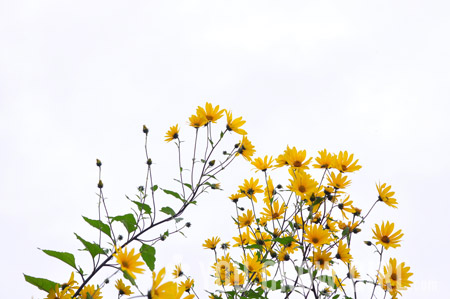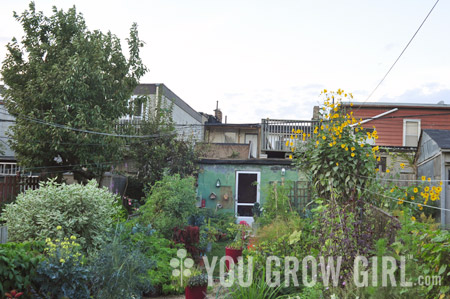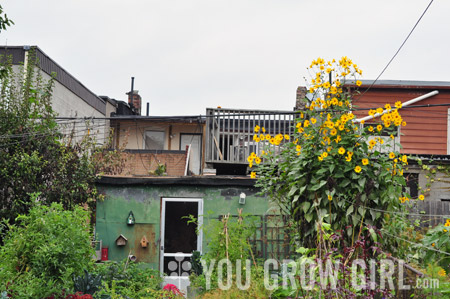
Besides weeds and a stronghold of goldenrod, Jerusalem artichoke (Helianthus tuberosus) aka sunchoke was one of the few plants that we inherited when we moved into this place. At the time only dead stalks remained and I wasn’t quite sure what member of the Sunflower Family they were.
In the spring I pulled a few rogue stems up and the tell-tale tubers came out of the soil with them. My first thought was, “Yay, a surprise food!” and my second was, “Oh shit.”

For those that are unfamiliar, a bit of background. Jerusalem artichokes are a Sunflower Family plant that grow edible tubers that taste sort of like artichokes, hence their name. The tubers are often used as a “healthier” substitute for potatoes as they have a lower glycemic index. For this reason you will often see them for sale in health food stores, and if you are looking to grow the plant I would suggest going there first as a local tuber source rather than buying online. These plants are so easy to grow. If you have trouble growing potatoes, you will not have a problem with Jerusalem artichoke. They grow themselves.
And now for the bad news. This plant is persistent. You will never get rid of it once you’ve got it. EVER. NEVER EVER. No. Really.
I used to grow this plant in a large garbage can over at the roof garden, and despite toppling the container to extract the tubers, I was never able to get the tiniest pieces out of the soil. Every spring it would come back again full force. That was in a container. Just imagine what they can do in the ground.

And this is where I am today. It is late summer and my plants are well over 2 stories tall. I’d measure them but they are so tall, I am not sure how to go about that feat. They are definitely taller than the original stalks that were here when we moved in last year. They have surpassed them as well as the clothing line we installed. And then some. I can only blame care (watering, pruning, etc) as well as the duck manure I added to the soil in the spring for their dominance now.
Jerusalem artichokes taste best when they have been kissed by the cold. I will dig mine up come late fall, once a hard frost has hit but before the ground freezes. I will likely give much of it away as I predict an abundance that is too much for 2 people without suffering gastrointestinal distress (Sunchokes are often called “fartichoke” for a reason). And then in the spring I will pull up the excess that will inevitably attempt to spread far and wide.
I will not be so caring and generous next season. That’s a promise.
Holy Cow! I had no idea they were that persistant! You probably just saved me from decades of headaches – I was playing around with the idea of planting these along a fencerow. I like the garbage can idea, though…
Fartichoke! Love! They make me want a pig…RT @yougrowgirl Monster Jerusalem Artichoke Devours Garden Whole http://t.co/i9wuIcXD
One way to measure the height of something tall is to measure the shadow, measure the shadow of a ruler or short stick at the same time and do a proportion: shadow of ruler/ruler length = shadow of jerusalem artichokes/ x. Solve for x. (I think I got that okay but I’m open to correction. It’s 40+ years since I did algebra.) I would also mention that jerusalem artichokes may present digestion issues for some people so I would cook some from a store before committing to growing them.
I smiled when I read your post. I am back living in Nova Scotia and here they call this plant: the ‘shit house plant’ because people use to grow it to hide their outhouse. It grows everywhere here and effectively you can’t kill it.
Marie-Louise: I love that name!
Diane: Thanks for the help. I will try that.
Marie: I often see them planted that way.
I have never tasted it but would like to – it sounds good. I think the guy in the garden next to mine grew some this year – it’s taken over about half his plot – not sure he knows yet – I never see him – heheh – why am I laughing – it won’t jump into my garden now will it? The good news – I can’t believe I just learned some math as well about how to measure shadows.
How were they when growing in the container? Did they produce an abundant enough crop so that container gardening would be sufficient? Just wondering, as I’m thinking of giving them a try instead of potatoes.
love the abundance of plant life in your garden
perversely, this post makes me want to grow some next year, yes in a pot, love the monsterous proportions
Rachel: I think they produced enough for 2 people who don’t eat them regularly. Keep in mind that I used a VERY large container — a garbage can.